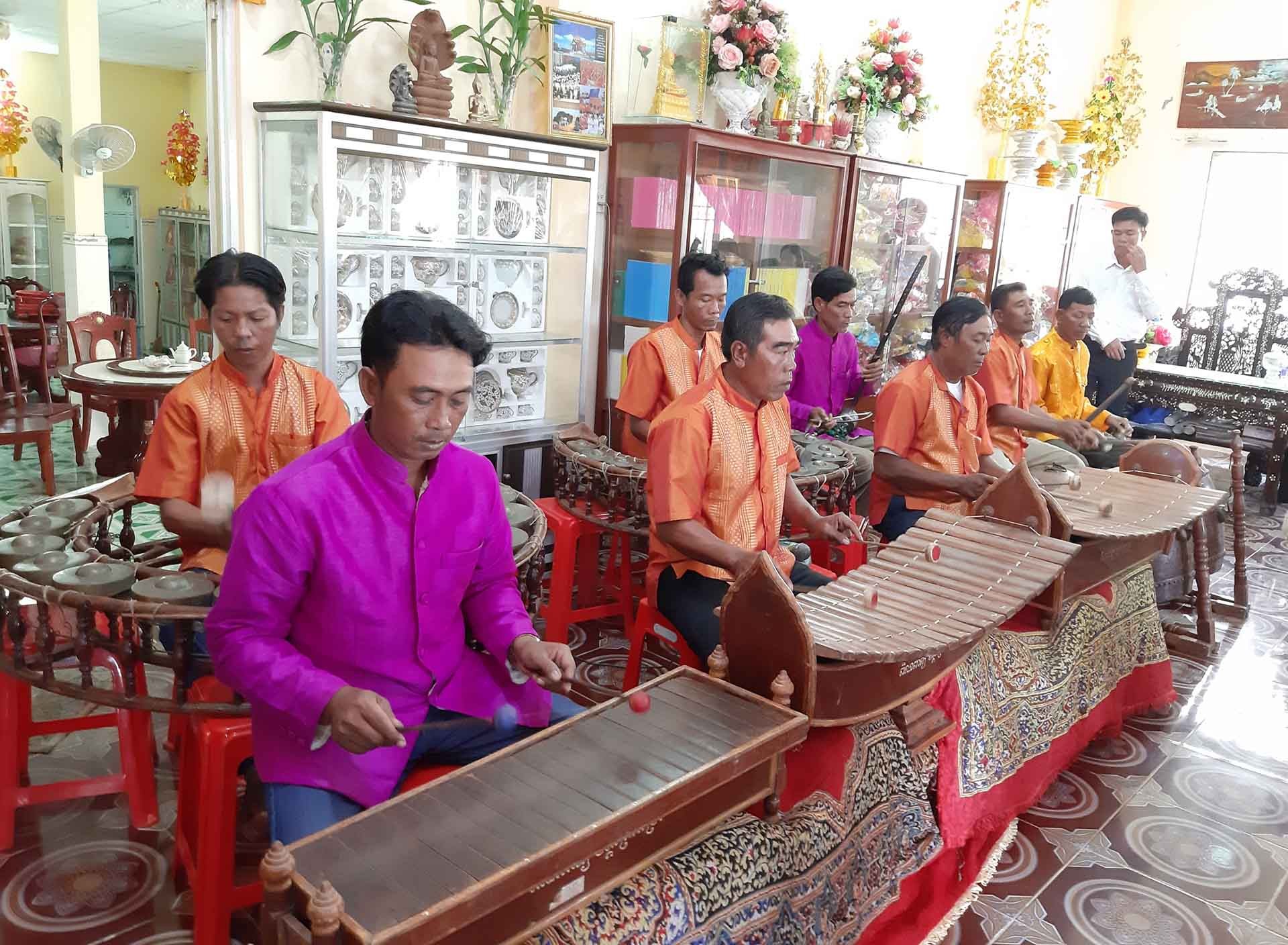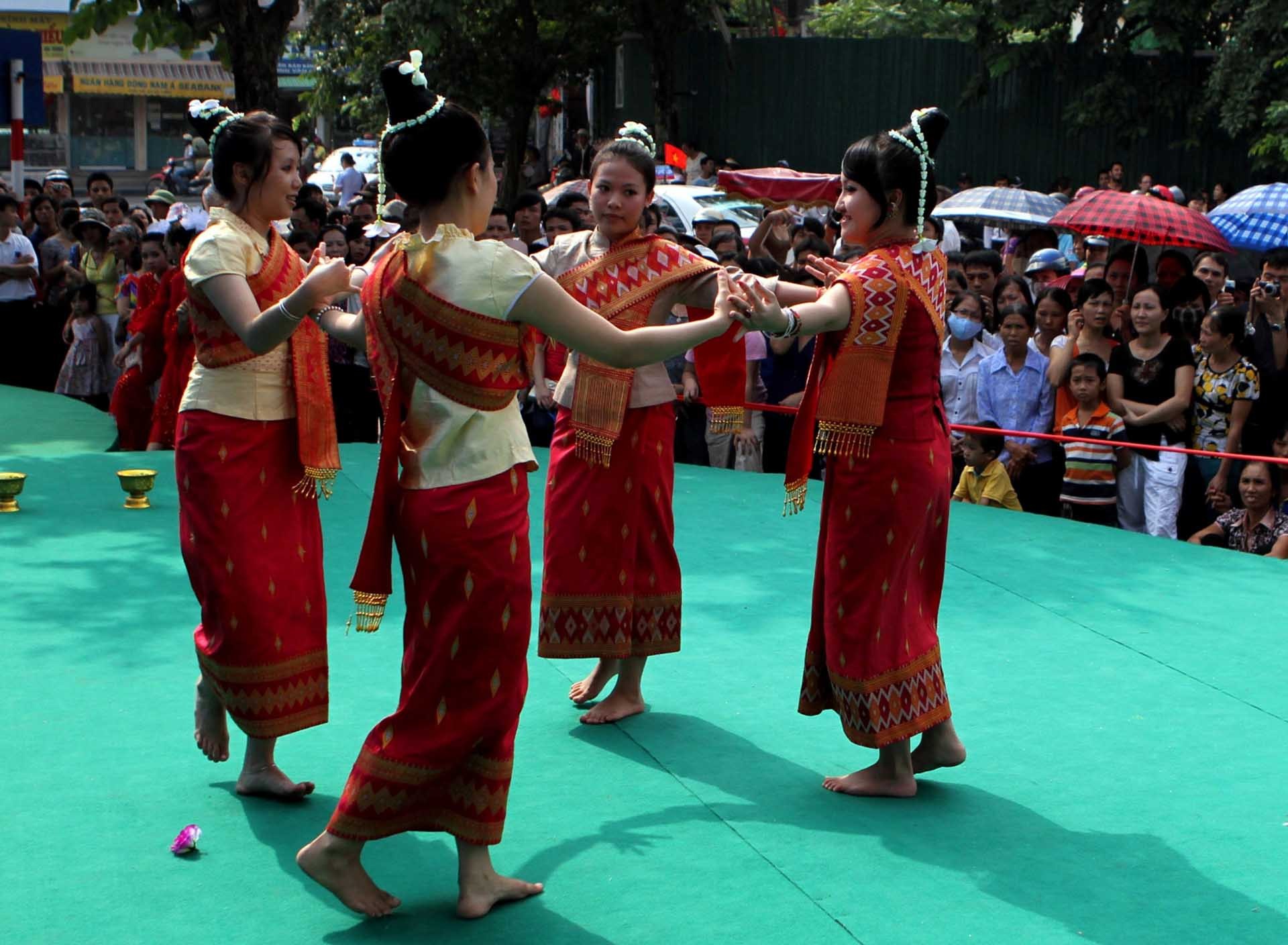
Artisans preserving intangible cultural heritages of Khmer people in Soc Trang
Latest
 |
| The performance of pinpeat orchestra of Chroy Tum Kandal temple at Dai Tam commune, My Xuyen district. (Photo: Phuong Nghi) |
Currently, Soc Trang is home to 8 intangible cultural heritages, of which 5 are specific to the Khmer community: the Ghe Ngo boat race festival, Du Ke theatrical performance art, Romvong folk dance, Pinpeat orchestra, and Ro Bam theater.
The performances of pinpeat orchestra, or Romvong dance always attract a large number of locals and tourists to enjoy and participate in activities during the festival days.
Master of Pinpeat orchestra
In the realm of Pinpeat orchestra in Soc Trang, Meritorious Artisan Danh Sol (Dai Tam commune, My Xuyen district) is widely recognized and revered as the master of the Pinpeat orchestra. Renowned not only as an elder pentatonic musician, he is also celebrated as the most skillful teacher of Pentatonic music in the Khmer community. Most Pinpeat musicians in Soc Trang under the age of 60 are his disciples.
Passionate about music, eager to learn and explore, at just 14 years old, Danh Sol became the youngest Pinpeat musician of the Pinpeat orchestra at Chroy Tum Kandal temple (Dai Tam commune, My Xuyen district). This year, despite his old age and weak health, the Meritorious Artisan Danh Sol still cares a lot about the temple’s orchestra. When he goes to serve at local events, just by listening to his students play some Pinpeat music, he immediately knows where there are issues with the musical instruments and where they are playing incorrectly.
Artisan Danh Sol’s reputation extends beyond Soc Trang. Over the years, he has been invited to pagodas in Can Tho, Bac Lieu, and Tra Vinh to impart his knowledge to their Pinpeat ensembles.
He said: “The greatest joy and happiness in my life is being able to pass on my knowledge to the younger generation. It proves that Pinpeat music is still preserved and passed down from generation to generation. Over time, the older members of the ensemble have aged and passed away, but their descendants have followed in their footsteps, and the pagoda’s ensemble continues to serve the community.”
Devoting a lifetime to traditional art
In Soc Trang, not only is there the Meritorious Artisan Danh Sol but there are also artisans who have devoted their entire lives to traditional art. One of them is Mrs. Lam Thi Huong, the head of the Khmer Ro Bam Art Troupe Resmay Bung Chong in Bung Chong hamlet (Tai Van commune, Tran De district). Despite poverty, three generations have been determined to preserve their Ro Bam group, even if it meant gradually selling off dozens of acres of land.
According to the meritorious artisan Lam Thi Huong, the younger generation today is no longer as passionate about Ro Bam as their ancestors were, and it is at risk of being lost. Recently, the troupe has trained more than a dozen children, aged 11-16, all from the same family and community. After a period of practice, these children have quickly shown talents suitable for the performance art of Ro Bam. These are the children who are passionate and enthusiastic about Ro Bam art form, so they have quickly absorbed the dance moves, dialogues, and performances.
“To have these successors, I, along with the members of the troupe and the local authorities, have made great efforts to persuade and motivate families to let their children join the troupe. This is not only to satisfy the children’s passion but also to prevent the Ro Bam art form from fading away,” shared Mrs. Huong.
Mr. Son Del (husband of Mrs. Huong), a member of the Khmer Ro Bam Art Troupe Resmay Bung Chong, said: “In order to nurture a proficient Ro Bam performer, training should commence when the actors are between 10-12 years old, as it becomes challenging to train them as they grow older. Hence, learning the Ro Bam stage art forms demands passion, perseverance, and the attention and investment of the relevant departments, fostering hope for its survival and development.”
In 2019, the Ro Bam art of the Khmer people in Soc Trang was honored to be recognized as a National Intangible Cultural Heritage by the Ministry of Culture, Sports and Tourism.
 |
| The palm is turned upwards, using the thumb and index finger to rub against each other in the fast and lively Rom Vong dance movements of the Khmer Art Troupe of Soc Trang province. (Photo: Phuong Nghi) |
“Homegrown” musicians
The “farmer” artists of the Du Ke Son Nguyet Quang Art Troupe (Vien An commune, Tran De district) spend their days farming, but during festival seasons, they perform to serve the local community. As they are not professionals, all members of the troupe serve voluntarily out of passion and a desire to preserve cultural heritage. Therefore, they only receive support when there is a performance, and the rest of the time they rely on their own resources, which somewhat limits their ability to gather.
Mr. Son Si Tha, the head of the troupe, shared: The Du Ke Son Nguyet Quang Art Troupe was established in 2000, taking over personnel from a disbanded group of art enthusiasts. The troupe currently has 29 members, with the youngest being 28 and the oldest nearing 60. Many of the props, costumes, and even the set decorations are sourced locally, embodying the spirit of “homegrown” resources.
Mr. Tha expressed, “The Khmer people want to preserve the Du Ke art for future generations, but it’s challenging. Here, during each important Khmer festival, the troupe strives to gather those who can perform, remember the plays, and write scripts, all to stage a Du Ke performance for the Khmer community to enjoy. During rehearsals, many locals come to my house to watch. The content of the Du Ke performances rarely changes, requiring individuals who understand the legends and melodies. However, I fear that soon there will be no one left to perform or write scripts, as they are getting older.”
In an exchange with us, Mr. Son Thanh Liem, Deputy Director of the Department of Culture, Sports and Tourism, said: “The province is focusing on implementing the project ‘Preserving and promoting the traditional cultural values of ethnic minorities associated with tourism development’ under the National Target Program for socio-economic development in ethnic minority areas for the period 2021-2030.”
This is a way for the cultural values of the Khmer people to contribute to the construction of a common culture of Vietnam - an advanced culture rich in national identity and united in the diversity of all ethnic brothers and sisters.
Along with economic development, Soc Trang province always identifies the preservation and promotion of cultural values as an indispensable factor in the life of the Khmer people. With a rich history, the Khmer people in Soc Trang have crystallized many unique cultural features, including various forms of art, belief culture, festival culture, etc.

















